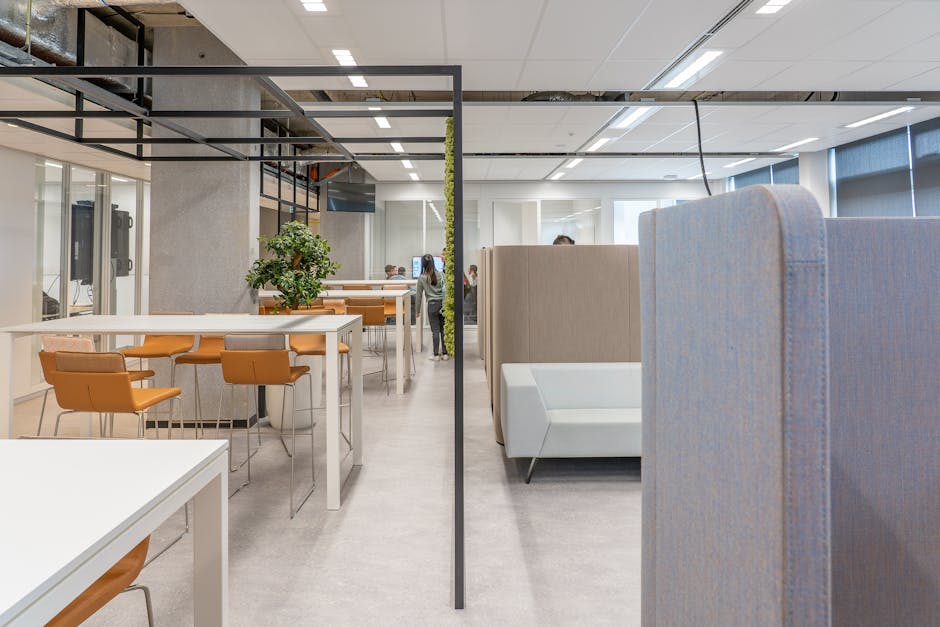Creating Effective Collaborative Workspaces: The Key to Modern Workplace Success
“Collaborative workspaces have become essential in today's business environment. This article explores how to create effective collaborative spaces that enhance team productivity, support knowledge sharing, and adapt to hybrid work models. Learn practical strategies for implementing technology, designing flexible spaces, and fostering a culture of collaboration in your organization. ”

The Rise of Collaborative Workspaces in Modern Business
In today's rapidly evolving business landscape, collaborative workspaces have emerged as a critical component of successful organizations. These purposefully designed environments facilitate teamwork, creativity, and knowledge sharing among employees, regardless of whether they're working in-person or remotely. According to recent research, collaborative workspace in Manhattan alone increased by nearly 70% in a single year, growing from 9.4 million square feet to 13.5 million square feet.
The shift toward collaborative workspaces isn't just a passing trend but a response to changing work dynamics and employee expectations. As organizations embrace hybrid work models and focus on innovation, creating spaces that support effective collaboration has become a strategic priority.

What Makes a Workspace Truly Collaborative?
A collaborative workspace goes beyond simply placing employees in an open floor plan. Effective collaborative spaces are thoughtfully designed environments that balance various work needs while providing the tools and technologies necessary for productive teamwork.
Key Elements of Effective Collaborative Workspaces:
-
Flexible Design: Spaces that can be reconfigured based on team needs, from small breakout areas to larger meeting zones.
-
Technology Integration: Seamless connectivity and collaboration tools that support both in-person and remote participation.
-
Acoustic Considerations: Sound management solutions that minimize distractions while enabling communication.
-
Visual Collaboration Areas: Writable surfaces, digital displays, and areas designed for ideation and brainstorming.
-
Comfort and Ergonomics: Comfortable, ergonomic furniture that supports extended collaboration sessions.
The most successful collaborative workspaces strike a balance between open areas for teamwork and quieter spaces for focused work, recognizing that effective collaboration requires both types of environments.
The Benefits of Well-Designed Collaborative Workspaces
Organizations that implement thoughtful collaborative workspaces can realize numerous benefits that impact both employee satisfaction and business outcomes.
Enhanced Communication and Knowledge Sharing
Collaborative spaces break down physical barriers between departments and team members, facilitating spontaneous interactions and knowledge exchange. This improved communication flow can lead to better knowledge management practices, where valuable information is shared more freely throughout the organization rather than remaining siloed.
Increased Innovation and Problem-Solving
When teams have dedicated spaces for collaboration, they're more likely to engage in creative problem-solving and innovation. These environments encourage diverse perspectives and cross-functional teamwork, which often leads to breakthrough ideas and solutions.
Improved Employee Engagement and Satisfaction
Well-designed collaborative spaces can significantly impact employee morale and satisfaction. According to workplace studies, employees who have access to effective collaborative environments report higher job satisfaction and stronger connections to their colleagues and the organization.
Optimized Space Utilization
For many organizations, collaborative workspaces represent an opportunity to optimize their real estate footprint. By creating multipurpose areas that support various types of work, companies can make more efficient use of their office space while supporting diverse work styles.

Technology's Role in Collaborative Workspaces
Technology serves as the backbone of modern collaborative workspaces, enabling seamless communication and workflow optimization across physical and virtual environments.
Essential Technologies for Collaborative Spaces:
-
Video Conferencing Systems: High-quality audio and video solutions that connect in-office and remote team members.
-
Digital Whiteboards: Interactive displays that allow for real-time ideation and documentation sharing.
-
Wireless Presentation Tools: Solutions that enable easy content sharing from multiple devices.
-
Room Scheduling Systems: Digital tools that simplify the process of finding and booking collaborative spaces.
-
Collaborative Software Platforms: Cloud-based applications that facilitate document sharing, project management, and team communication.
The integration of these technologies should be thoughtful and intuitive, focusing on creating a seamless experience rather than introducing complexity. The goal is to enhance collaboration, not create technological barriers.
Designing Collaborative Spaces for Different Work Styles
Effective collaborative workspaces acknowledge that collaboration takes many forms and that teams have diverse needs based on their work styles and objectives.
Types of Collaborative Spaces to Consider:
-
Huddle Rooms: Small, informal spaces equipped with basic technology for quick team meetings and discussions.
-
Project Rooms: Dedicated spaces where teams can work together over extended periods, with tools and materials that remain in place between sessions.
-
Social Hubs: Casual areas designed to encourage spontaneous interactions and relationship building.
-
Innovation Labs: Specialized spaces equipped with tools and technologies for creative problem-solving and ideation.
-
Virtual Collaboration Zones: Areas specifically designed to support high-quality interactions with remote team members.
By providing a variety of collaborative environments, organizations can support different types of teamwork and ensure that employees have access to the right space for their specific needs.
Balancing Collaboration and Focus in the Workplace
While collaborative workspaces offer numerous benefits, it's essential to recognize that effective work environments must also support focused individual work. Finding the right balance is critical for overall productivity and employee satisfaction.
Strategies for Balancing Collaboration and Focus:
-
Designated Quiet Zones: Areas specifically designed for concentrated work, with minimal distractions.
-
Acoustic Solutions: Sound-absorbing materials and design elements that minimize noise disruption.
-
Clear Protocols: Established guidelines for when and how to use different types of spaces.
-
Flexible Scheduling: Options for employees to schedule focused work time when needed.
-
Personal Work Areas: Dedicated spaces where individuals can retreat for concentrated work.
Organizations that successfully balance collaborative and focused work environments recognize that both are essential components of a productive workplace. By providing options for different work modes, they empower employees to choose the right environment for their specific tasks.

Implementing Collaborative Workspaces in a Hybrid Work Model
The rise of hybrid work has introduced new challenges and opportunities for collaborative workspaces. Organizations must now design environments that effectively support collaboration between in-office and remote team members.
Best Practices for Hybrid Collaborative Spaces:
-
Technology Parity: Ensuring that remote participants have an equivalent experience to those in the office.
-
Inclusive Meeting Protocols: Establishing practices that give equal voice to in-person and remote team members.
-
Digital Collaboration Tools: Implementing platforms that enable real-time collaboration regardless of location.
-
Flexible Office Design: Creating spaces that can adapt to varying numbers of in-office employees.
-
Hybrid-Friendly Scheduling: Coordinating in-office days to maximize meaningful collaboration opportunities.
The future of collaborative workspaces lies in their ability to seamlessly connect in-person and remote experiences, creating an inclusive environment where all team members can contribute effectively regardless of their location.
Measuring the Success of Collaborative Workspaces
To ensure that collaborative workspaces are delivering the intended benefits, organizations should establish metrics and feedback mechanisms to evaluate their effectiveness.
Key Performance Indicators for Collaborative Spaces:
-
Space Utilization Rates: How frequently different collaborative areas are being used.
-
Employee Feedback: Regular surveys and discussions to gather input on workspace effectiveness.
-
Collaboration Outcomes: Metrics related to project success, innovation, and problem-solving.
-
Technology Adoption: Usage rates for collaborative tools and technologies.
-
Business Impact Metrics: Connections between collaborative initiatives and broader business outcomes.
By regularly assessing these metrics and making adjustments based on findings, organizations can continuously improve their collaborative environments to better meet team needs and business objectives.
Creating a Culture That Supports Collaboration
Even the most thoughtfully designed collaborative workspace will fall short if the organizational culture doesn't support and encourage collaboration. Building a collaborative culture requires intentional leadership and clear communication.
Elements of a Collaborative Culture:
-
Leadership Modeling: Executives and managers demonstrating collaborative behaviors.
-
Recognition and Rewards: Acknowledging and celebrating successful collaborative efforts.
-
Skills Development: Training programs focused on building collaborative capabilities.
-
Cross-Functional Opportunities: Creating structured opportunities for teams to work across departmental boundaries.
-
Psychological Safety: Fostering an environment where team members feel comfortable sharing ideas and taking risks.
Organizations that successfully implement collaborative workspaces recognize that physical environment and culture must work together to create truly effective collaboration.
Conclusion: The Future of Collaborative Workspaces
As work continues to evolve, collaborative workspaces will remain a critical component of successful organizations. The most effective spaces will blend physical design, technology, and cultural elements to support meaningful collaboration regardless of where team members are located.
The future of collaborative workspaces will likely see increased personalization, with environments that can adapt to individual and team preferences through smart technology and flexible design. We'll also see greater integration between physical and digital collaboration tools, creating seamless experiences that transcend location.
Organizations that invest in thoughtful collaborative workspaces position themselves for success in an increasingly complex and competitive business landscape. By creating environments that support effective teamwork and knowledge sharing, they enable their employees to solve problems, innovate, and drive business results more effectively.
By embracing the principles of effective collaborative workspace design and implementation, organizations can create environments that not only support their current work needs but also adapt to future changes in how and where work happens.